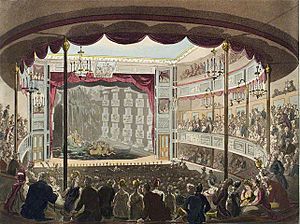Charles Dibdin the younger facts for kids
Charles Isaac Mungo Dibdin (born October 17, 1768 – died January 15, 1833) was an English writer, composer, and theatre owner. He was also known as Charles Pitt or Charles Dibdin the younger. He is most famous for owning the Sadler's Wells Theatre. He also wrote many pantomimes and funny plays called farces. These plays were shown in many London theatres.
Charles Dibdin the younger worked with the famous clown Joseph Grimaldi at Sadler's Wells. Grimaldi starred in many of his most popular pantomimes. Charles was the son of the composer Charles Dibdin and the brother of Thomas John Dibdin. He was also the godson of the famous actor David Garrick.
Contents
Biography
Early Life and First Steps in Theatre
Charles Dibdin was born in London. His father was the composer Charles Dibdin, and his mother was the actress Harriett Pitt. He was named after his father's friend, Isaac Bickerstaffe.
Charles first appeared on stage in 1775 with his younger brother Thomas John Dibdin. They were in a play called The Jubilee, which was written by their godfather, David Garrick. After this, his parents separated, and Charles started using his mother's last name, Pitt.
His mother did not want him to become an actor. So, she arranged for him to work for his uncle, who made furniture. Charles went to school in Hackney, London, and then to a boarding-school in County Durham. He stayed there from age nine to fourteen without a holiday. When he was 14, he returned to London and worked for a pawnbroker for several years.
Charles loved writing. In 1792, he published a book of poems called Poetical Attempts: by a Young Man. In 1796, he and his brother Thomas wrote a Christmas pantomime called The Talisman; or, Harlequin Made Happy.
In 1797, he started performing again in a one-man show. He became known as Charles Dibdin the younger. That same year, he married actress Mary Bates. They had eleven children together.
Soon after his marriage, Charles sold a pantomime based on the story of Don Quixote to Philip Astley. Astley also hired Charles to write for his theatre, Astley's Amphitheatre, for three years. Astley was a very strict boss. He made Charles write twelve short musical plays (called burlettas), twelve pantomimes, and twelve harlequinades every year.
In 1799, Charles was offered a job by Richard Hughes, the manager of Sadler's Wells Theatre. He was hired to write pantomimes and harlequinades for the next year. These included Harlequin Benedick and The Great Devil, both starring Joseph Grimaldi.
Becoming a Theatre Leader
Charles and his wife toured with Astley's company, performing in cities like Dublin and Liverpool. During this time, Charles became a very active composer. He wrote many songs, introductions (called prologues), and closing speeches (called epilogues). He also wrote one-act musical plays.
In 1799, Charles left Astley's. His wife had been fired for sewing during rehearsals. That autumn, the Dibdins joined a touring horse show company. They performed in cities like Liverpool, Bristol, and Manchester.

In 1800, Charles Dibdin became the manager of Sadler's Wells Theatre in London. One of the first shows under his management was the pantomime ballet Filial Love, or the Double Marriage. He hired many famous performers, including Edmund Kean and Joseph Grimaldi. He also hired singers, tightrope-walkers, and pugilists (boxers).
Charles introduced many of his own works, which were very popular. These shows helped Sadler's Wells become very successful. By 1802, Charles, his brother Thomas, and a group of wealthy businessmen became owners of the theatre. In 1803–1804, Charles installed a large water tank in the theatre. He advertised it as an "aquatic theatre" that performed plays in water, called aqua dramas.
On October 15, 1807, a sad event happened at the theatre. A false fire alarm caused people to panic and rush to escape. Eighteen people were killed. Even though his theatre survived this disaster, times became tough. The Napoleonic wars (1803-1815) made people less interested in the kind of entertainment Charles offered.
His business faced tough times, and he ended up in financial trouble. In 1819, he declared bankruptcy. He was able to get out of debt two years later by selling his shares in Sadler's Wells. He continued to write songs and pantomimes for various London theatres. He also worked as a stage director at the Royal Amphitheatre from 1822–1823 and as a manager at the Surrey Theatre from 1825–1826.
Later Years and Legacy
Charles Dibdin published several poems, including Young Arthur, or, The Child of Mystery: a Metrical Romance in 1819. He also wrote A History of the London Theatres, which was published in 1826 and was very well-received. His last play was a farce called Nothing Superfluous, which was performed in Hull in 1829. He finished writing his life story (memoirs) the following year, but they were not published until 1956.
Charles Dibdin died in 1833 at the age of 63. He was buried at St James's Chapel in Pentonville. In 2010, a musical artwork dedicated to him was placed in the park during its renovation. The author Andrew McConnell Stott described Charles Dibdin as "a cheerful, tireless and frequently prosperous man with a love of patriotic ballads and convivial dinners."


